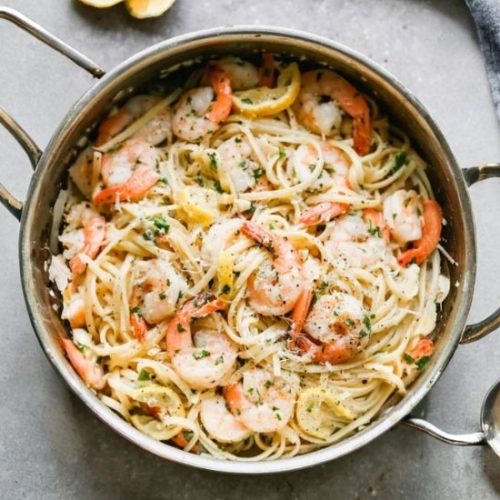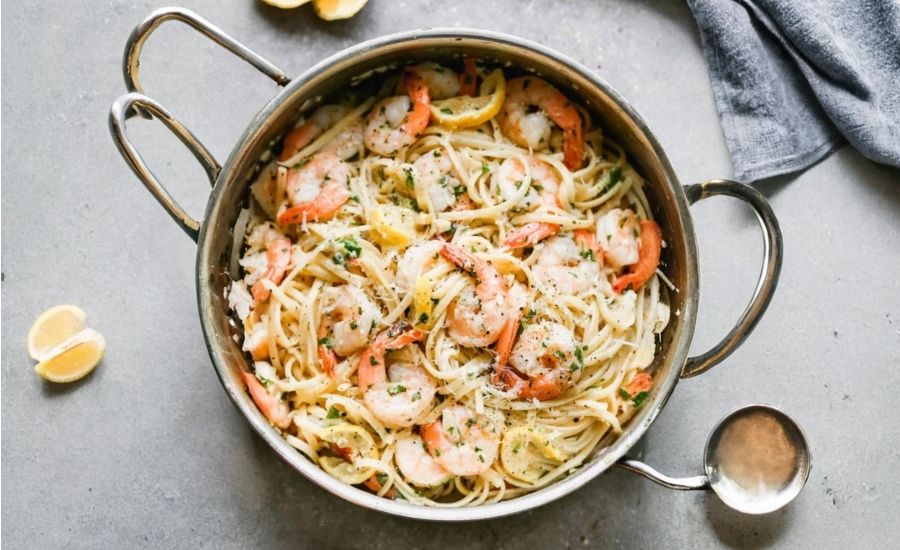All products are selected by our editorial team for quality. If you buy through our links, we may earn a small commission at no extra cost to you.
This Shrimp Linguine recipe stands out for its bright, fresh flavors and quick preparation time, making it an ideal choice for busy weeknights or effortless entertaining.
The luscious lemon butter sauce, enriched with garlic and fresh parsley, perfectly complements the succulent shrimp, creating a harmonious balance of richness and zest.
Nutritionally, this dish offers a healthy boost of lean protein from the shrimp and heart-healthy fats from olive oil and butter, while maintaining moderate carbs from linguine.
It’s a fiber-light recipe, but the addition of fresh lemon juice and parsley contributes vitamins C and A, enhancing the dish’s nutritional profile.
The recipe is versatile, easy to customize with veggies or zucchini noodles for lower carbs, and requires minimal cleanup.
Overall, it delivers a satisfying, restaurant-quality meal that’s accessible for everyday cooking or meal prepping, thanks to its straightforward technique and quick cook time.
Must-Have Tools for Perfect Results
Large Pot for Boiling Pasta
Essential for cooking linguine evenly and preventing sticking. Its high capacity allows for plenty of water to ensure perfectly al dente pasta every time. A kitchen staple for all pasta dishes.
Extra-Large Skillet
Perfect for sautéing shrimp and garlic evenly without overcrowding. Its wide surface area ensures thorough cooking and allows you to toss ingredients easily, making it indispensable for one-pan meals.
Garlic Press
Efficiently minces garlic cloves quickly and uniformly, releasing maximum flavor into the sauce. This handy tool speeds up prep time and is a must-have for garlic lovers.
Microplane Zester
Ideal for zesting lemons finely to infuse bright citrus flavor without bitterness. A versatile tool that elevates sauces, desserts, and marinades effortlessly.
Colander
Allows quick and safe draining of pasta water to prevent sogginess. Durable and easy to handle, it’s a must for efficient kitchen workflow.

Zesty Lemon Butter Shrimp Linguine
Equipment
- 1 Large Pot (for boiling linguine)
- 1 Extra-Large Skillet (for sautéing shrimp and sauce)
- 1 Garlic Press (for mincing garlic)
- 1 Microplane Zester (for lemon zest)
- 1 Colander (for draining pasta)
Ingredients
- 1 pound linguine pasta white or whole wheat
- 4 tablespoons unsalted butter
- 3 tablespoons extra virgin olive oil
- 5 garlic cloves finely minced
- 1 pound large shrimp peeled and deveined (about 20 shrimp)
- Salt to taste
- Freshly ground black pepper to taste
- ½ cup fresh parsley chopped
- Zest from 1/2 large lemon
- ¼ cup fresh lemon juice approximately 2 lemons
- ½ lemon thinly sliced into half-moons
- Crushed red pepper flakes optional and to taste
- ½ cup freshly grated Parmesan cheese
Instructions
- Prepare the Pasta: Fill a large pot with water and bring it to a rolling boil. Add a pinch of salt and a splash of olive oil to the water to keep the pasta from sticking. Cook the linguine according to the package directions until it reaches al dente texture. Once cooked, drain the pasta but reserve a small amount of pasta water just in case you want to loosen the sauce later.
- Season the Shrimp: While the pasta cooks, pat the shrimp dry with paper towels. Sprinkle them evenly with salt and freshly ground black pepper to enhance their natural flavor. Set aside until ready to cook.
- Sauté Garlic and Shrimp: In a large skillet over medium-low heat, melt the butter together with the olive oil. Once melted, add the minced garlic and gently cook for about one minute until fragrant, taking care not to let it brown or burn. Increase heat to medium and add the seasoned shrimp. Cook the shrimp for 4 to 5 minutes, stirring frequently, until they turn pink and are just cooked through.
- Build the Lemon Butter Sauce: Remove the skillet from heat. Stir in the chopped parsley, lemon zest, fresh lemon juice, and the thin lemon slices.Add crushed red pepper flakes to your desired heat level. Toss everything gently to combine, adjusting salt and pepper as needed for a balanced flavor.
- Combine Pasta and Sauce: Add the drained linguine directly to the skillet with the shrimp and sauce. Toss everything carefully to coat the pasta evenly with the lemon butter mixture. If the sauce feels too thick, add a splash of the reserved pasta water to loosen it.
- Serve with Parmesan: Plate the shrimp linguine and generously sprinkle freshly grated Parmesan cheese over the top. Serve immediately while warm and enjoy a bright, flavorful meal.
Notes
- Add a splash of white wine: For a subtle depth of flavor, add 1/4 cup of dry white wine to the skillet after cooking the garlic, allowing it to reduce for a few minutes before adding shrimp.
- Boost with veggies: For extra nutrition and color, toss in chopped asparagus tips or halved cherry tomatoes when adding shrimp.
- Low-carb alternative: Substitute linguine with spiralized zucchini noodles for a lighter, gluten-free option. Add zucchini at the final step just long enough to warm through.
- Shrimp tips: To avoid overcooking, watch shrimp closely; they cook fast and become rubbery if left too long. Remove from heat as soon as they turn opaque pink.
- Leftovers: Store any leftovers in an airtight container in the fridge for up to 2 days. Reheat gently with a splash of water or broth to keep the sauce from drying out.
Chef’s Secrets for Flavorful Success
Mastering this shrimp linguine begins with careful timing and quality ingredients.
Using fresh shrimp is key—they cook quickly and add a sweet, delicate flavor that’s hard to beat.
When sautéing the garlic, keep the heat moderate to prevent burning, which can turn the sauce bitter.
Incorporate both butter and olive oil to achieve a rich, silky texture with a balanced taste.
Don’t underestimate the power of fresh lemon zest and juice; they brighten the entire dish and bring out the shrimp’s natural sweetness.
Toss the pasta directly in the skillet with the sauce to ensure every strand is evenly coated.
Finally, use freshly grated Parmesan rather than pre-grated cheese to maintain a creamy melt and robust flavor.
These small steps elevate a simple recipe into an impressive, restaurant-quality meal.
Serving Suggestions to Impress Guests
This shrimp linguine pairs wonderfully with crisp, refreshing sides to balance its buttery richness.
Consider serving it alongside a light mixed green salad dressed with lemon vinaigrette or a simple arugula salad with shaved Parmesan and pine nuts.
For a heartier meal, roasted asparagus or garlic sautéed spinach complement the lemon and garlic notes beautifully.
A chilled glass of crisp white wine, such as Pinot Grigio or Sauvignon Blanc, enhances the citrus and seafood flavors.
To add some texture, warm, crusty bread or garlic breadsticks are perfect for soaking up the luscious sauce.
Garnish the plated dish with extra parsley and a lemon wedge for a fresh, colorful presentation.
Storage Tips for Freshness and Flavor
To keep your shrimp linguine tasting fresh, allow the dish to cool to room temperature before storing it in an airtight container.
Refrigerate leftovers promptly and consume within two days for optimal flavor and food safety.
When reheating, gently warm the pasta in a skillet over low heat, adding a splash of water or broth to restore the sauce’s creaminess and prevent dryness.
Avoid microwaving on high, which can toughen the shrimp and make the pasta rubbery.
If you plan to meal prep, consider storing the sauce separately from the pasta and shrimp to maintain texture and reheat evenly.
Frequently Asked Questions Answered Clearly
1. Can I use frozen shrimp for this recipe?
Yes, frozen shrimp works well. Thaw them completely and pat dry before cooking to prevent excess moisture from diluting the sauce.
2. Is it necessary to peel and devein the shrimp?
For the best eating experience, peeling and deveining shrimp is recommended, as the shells can be tough and the vein can have grit or bitterness.
3. Can I make this recipe gluten-free?
Absolutely! Swap traditional linguine for gluten-free pasta or zucchini noodles for a low-carb alternative.
4. How can I make this dish spicier?
Increase the amount of crushed red pepper flakes or add a pinch of cayenne pepper while sautéing the garlic for an extra kick.
5. What can I substitute for Parmesan cheese?
If you’re avoiding dairy, nutritional yeast offers a cheesy flavor, or you can try vegan Parmesan alternatives available in most grocery stores.
This recipe is inspired by tastesbetterfromscratch and has been carefully refined to enhance clarity, streamline preparation steps, and ensure accurate results. We’ve also included health benefits, nutritional highlights, and Must-Have Tools to help you get the best results every time you cook.


